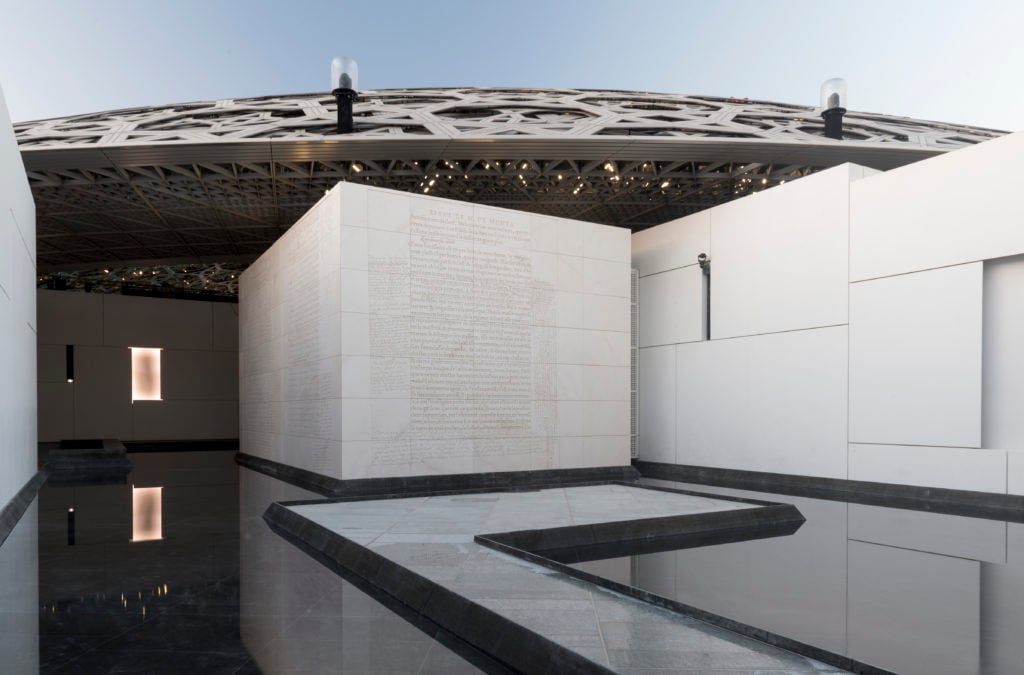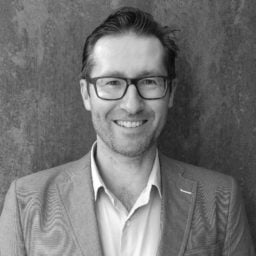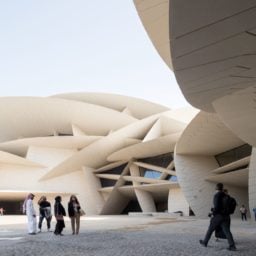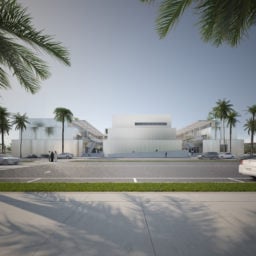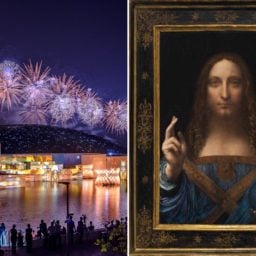The spectacular Louvre Abu Dhabi, the Emirate’s first museum to open on the much-delayed mega-project of Saadiyat Island, opens to the public on Saturday, November 11. An aerial show, fireworks, as well as a “stunning extravaganza” of music-and-light are planned to celebrate Jean Nouvel’s futuristic dome and the museum of global civilizations beneath.
But first there are the official ceremonies to celebrate this United Arab Emirates and French cultural partnership. The Louvre Abu Dhabi was in lockdown on November 8th as the French President Emmanuel Macron attended its royal opening. No mere outpost of the Paris museum, the $1 billion Louvre Abu Dhabi is the result of an intergovernmental agreement signed in 2007.
Jean-Luc Martinez, the president of the Louvre Museum, stressed at the media preview that the Louvre Abu Dhabi is an Emirate museum. Indeed, no one could mistake the landmark building on the tip of Saadiyat Island as a mini-me Musée du Louvre. The complex of 55 buildings is sheltered by a vast, 180-meter-diameter dome, which at 7,500 tons weighs just short of the Eiffel Tower.

Jean-Luc Martinez, president of the Musée du Louvre ©Louvre Abu Dhabi Photo: Mohamed Somji.
What’s on View—and What Isn’t
Martinez singled out key works on a whistle-stop tour of the permanent galleries, which include hundreds of loans from France alongside works in the Louvre Abu Dhabi’s collection. French curators have advised the Emirates to acquire 235 works so far. Among the newly acquired works are spectacular bronzes, a dragon from China, head of a Benin king, and, from either Moorish Spain or southern Italy, a lion. The lion houses a mechanism that may have meant it could roar, Martinez said with pride at this major acquisition first revealed this week (prices were not disclosed). Details of provenance are missing-in-action in the captions of this and any of the works on display, and will have to wait until a catalogue appears.
Works from the collection of the Louvre Abu Dhabi are shown alongside 300 loans from the Louvre and 12 other leading French institutions, coordinated by Agence France-Muséums. The French institutions range from the Musée Rodin to the Chateau Versailles, and will lend works to the Louvre Abu Dhabi for the next ten years, while the Louvre has lent its name for the next 30 years in the reported $525 million deal.
The Louvre’s president was keen to point out a prestigious loan that is not from France: One of the first sculptures visitors see is a monumental statue with twin heads from Jordan (around 6500 BCE) lent by its department of antiquities.
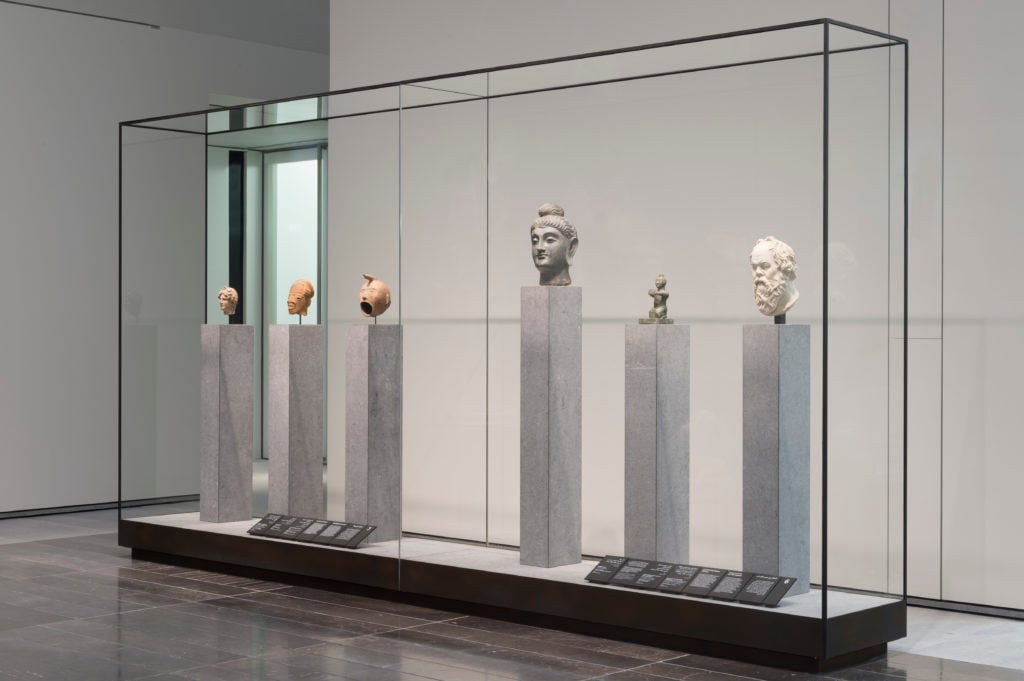
Talking head: Socrates meets Buddha. ©Louvre Abu Dhabi. Photo: Marc Domage.
At the press conference, Martinez said that the museum is the most ambitious of the early 21st century. He hoped it would be “an antidote to the poison of hatred and barbarism,” referring to attacks on cultural heritage in Mali, Syria, and Iraq. This was echoed by Mohamed Khalifa Al Mubarak, the chairman of the Abu Dhabi Tourism & Culture Authority, which is in charge of the project. He said the museum aims to “broadcast tolerance” and showed how the Emirate was a “dynamic, vibrant, and multicultural society.”
The architect Jean Nouvel shrugged off references to his “genius” in transforming the tip of what he called the “desert island” of Saadiyat into a cultural destination. The elephant in the room was when, or indeed whether, the other planned museums would be built. That said, they are listed in the publicity material and even Thomas Krens, the former director of the Guggenheim who hoped that a Saadiyat Island satellite would be his swan song, was name-checked in the press conference.
The vast majority of the island is an empty, sandy site earmarked for golf courses, luxury homes, and more shopping malls for the time being. But Frank Gehry’s Guggenheim Abu Dhabi and Foster + Partners’s Zayed National Museum “need to be built,” Nouvel said. In the meantime a few works from their collection can be seen in the Louvre Abu Dhabi’s inaugural installation.
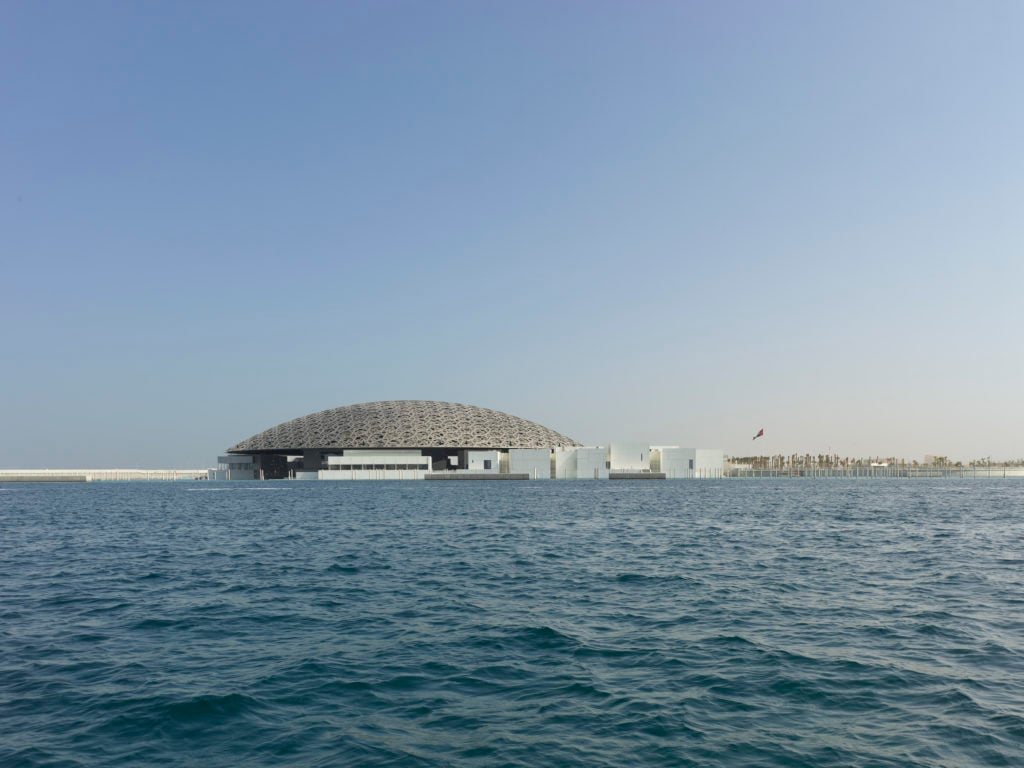
Louvre Abu Dhabi, exterior view. ©Louvre Abu Dhabi. Photo by Roland Halbe.
The delay to the Guggenheim partly explains why the Louvre Abu Dhabi features contemporary art far more prominently than originally planned. On an exterior wall, artist Jenny Holzer has created three monumental text pieces in stone. Her limestone reliefs For the Louvre Abu Dhabi (2017) are based on a Mesopotamian clay tablet, a 14th-century text by an Islamic scholar Ibn Khaldun and a page of writing by Montaigne annotated by the French philosopher.
Of Giuseppe Penone’s three-part installation Germination (2017), a bronze tree with angular leaves of mirrors works best with Nouvel’s architecture. The Italian artist’s two ceramic works are shown behind glass and so their impact is lessened. Rodin’s Walking Man, on a Column (1907), which is placed by Holzer’s supersized clay tablet, reminds visitors that this is a French-Emirate co-production.
The Architecture Both Dominates and Enlivens
Nouvel’s building does not disappoint as an architectural power statement rich in Arab symbolism and at the same time futuristic. The massive, shallow dome both dominates and enlivens the space below. Constructed of eight layers of interlocking steel and aluminum creating a design of more than 7,800 “stars,” its complex geometry provides vital shade for the public spaces. Pierced by sunlight during the day, the dome becomes a “constellation” of stars at night.
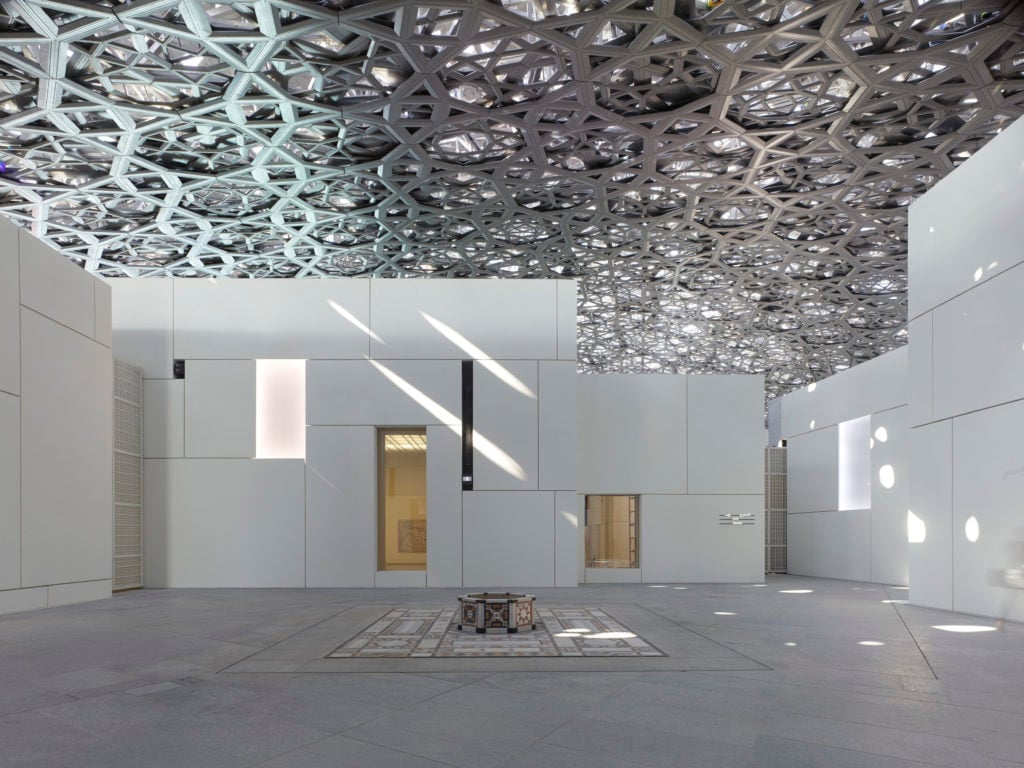
Jean Nouvel has designed a “medina” beneath a dome. ©Louvre Abu Dhabi. Photo by Roland Halbe.
A “village” of white-walled buildings houses the museum below the dome. There are 23 galleries for the permanent collection, a huge temporary exhibition space the size of a soccer field that measures 2,000 square metres, a children’s museum, and waterside restaurant. The various pavilions are clustered together to create a modern version of an Arab “medina” that is comfortable to navigate. The complex is also designed to be a social space in the evenings. (The museum is open until 8 pm and until 10 pm on two late nights.)
Nouvel’s achievement in Abu Dhabi confirms his status as the go-to architect for national museums. The French starchitect has extended the Reina Sofía in Madrid, designed a national museum in Beijing for China, and is working on another for Qatar. (The National Museum of Qatar is not mentioned in Abu Dhabi as the Emirate is one of the Gulf nations blockading Qatar along with Saudi Arabia. Qatar rejects its neighbors’ accusation that it supports terrorists.)
Originally due to open in 2012, the Louvre Abu Dhabi that visitors will discover could easily have been a hodgepodge of trophy acquisitions and high-profile loans. They are on show, of course, including a Mondrian once owned by Yves Saint Laurent bought by Abu Dhabi. Another prize purchase is Bellini’s Madonna and Child (1480-85). From the Louvre comes da Vinci’s La Belle Ferronnière. Jean-Luc Martinez’s promotion to president in 2013 from within the curatorial ranks of the Louvre was a turning point in the project. Together with Jean-Francois Charnier, the scientific and cultural director of Agence France-Muséums, they have ensured that the inaugural installation of the permanent galleries has style and substance. They eloquently convey big ideas through the thoughtful and often beautiful display of objects. This is no “book on the wall” nor is it an art museum where the objects are supposed to simply “speak for themselves.”
“A Museum Like No Other”
The Louvre Abu Dhabi is a museum of juxtapositions and chronology, with much stress on shared humanity and fraternity down the ages. In an introductory gallery among the cross-cultural comparisons of artifacts are three ancient gold masks from China, Peru, and the Middle East. In the gallery about art in the service of power called “the Magnificence of the Court,” Benin bronzes are juxtaposed with a bronze equestrian statue of King Philip of Spain by Lorenzo Vaccaro (1702-05). An African sculpture from Gabon is shown side-by-side with Duchamp’s Bottle Rack in the gallery about Modernity in the 20th century.
Only in the final gallery of contemporary art does the hang feel forced and predictable. That space is dominated by Ai Weiwei’s made-to-measure, crystal-and-steel Flower of Light (2016), a riff on Tatlin’s Tower and the Tower of Babel.
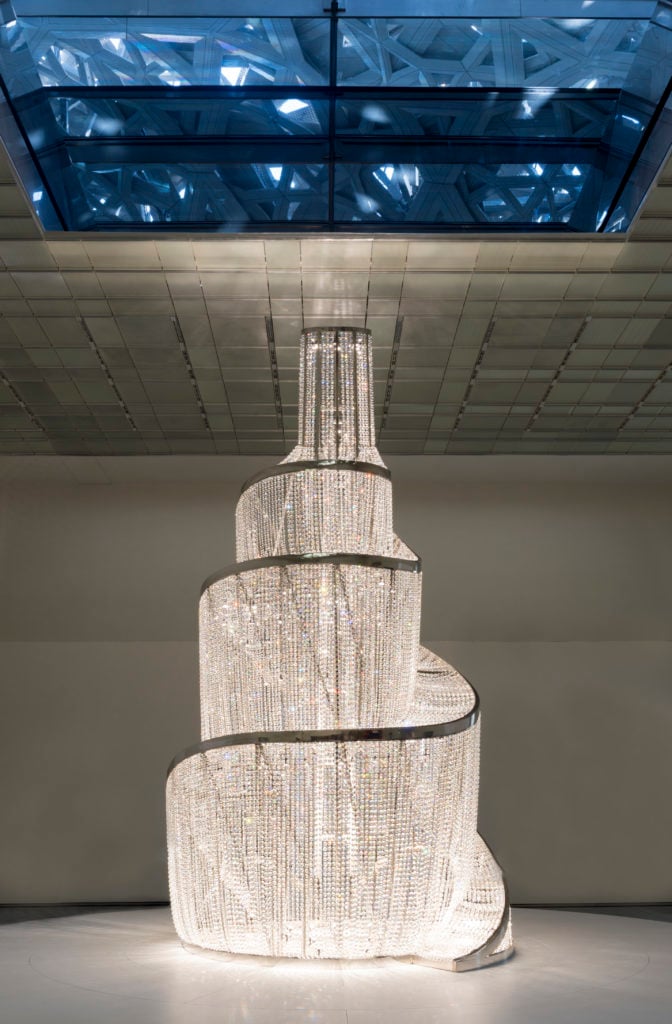
Ai Weiwei, Fountain of Light, (2016) ©Louvre Abu Dhabi. Photo by Marc Domage.
The Louvre Abu Dhabi is “a museum like no other,” Martinez said. On one level it is a radical revision of the great encyclopaedic museum. But the stress on equality across eras and cultures sits oddly with the blind eye it turns to the long history of human inequality and exploitation. A 17th-century painting of a slave plantation is labeled “The residence of a sugarcane planter in Brazil,” for example. No mention is made to European or Arab trade in Africans down the centuries; the most notorious forced migration in history, and not even a slave shackle is on display.
Jean-Francois Charnier acknowledges this oversight, aware that nearby Oman, which like Abu Dhabi is part of the Arabian peninsula, was a profit center of the slave trade long before oil and gas were discovered under its sands. “This is a start,” he says. For the time being, what he calls “a book in 12 chapters” tells an inclusive history only up to a point.
